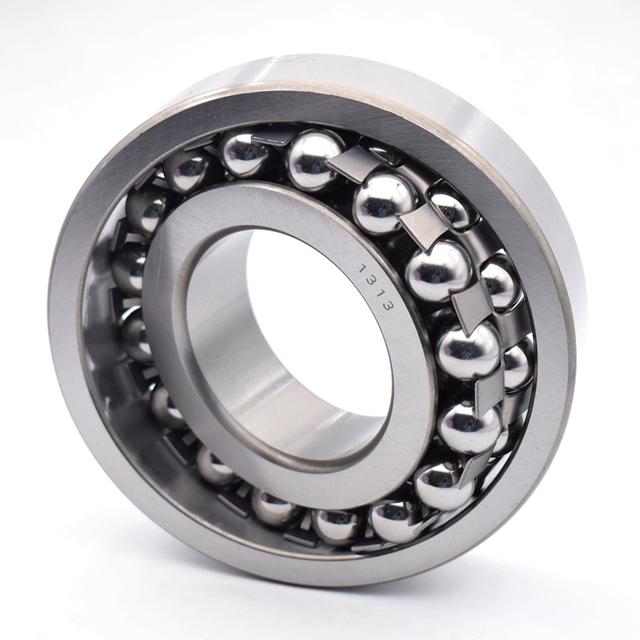The Design of Self-Aligning BallBearing
In particular, Self-Aligning ball bearings are preferable for applicationsand situations where errors cause misalignmentin shaft deflection ormounting. Keeping in view the small capacity, the Self-Aligning ballbearing should only be used in light axialload applications. However, incases where the axialload carrying capacity is not enough, sphericalroller bearings can be used as they have similar propertiesto Self-Aligning ball bearings. These bearings are adjusted witha polyamidecage or a pressed steel cage. The polyamide cage isindicated on thesurface of the package of the Self-Aligning ball bearing.
Important Considerations
.The maximum angle permitted for misalignmentis2.5*in the 12 and 22 series. Similarly, in the 13and 23series, the maximum angleallowed for misalignment is 3'.As the Self-Aligning ball bearing
operates in a fully misaligned condition, itis necessary to take proper care and provide adequate clearance between the Self-Aligning bearing and the surrounding structure.
As the speed increases,there are chances for the misalignedbearings to become noisy. The practical misalignment of the Self-Aligningball bearings may be less than the actual maximum
Atemperature of less than 12O°should be used for Self-Aligningball bearings with a polyamide cage.The bearings with tapered bore after mounting make it difficult tomeasure the running clearance. Sufficient experience and techniqueare required to mount Self-Aligning ball bearings with a tapered bore.
Manufacturing of Self-Aligning Ball Bearing
Self-Aligning ball bearings fallunder the category of ball bearings which allows asmooth and friction-lessrotary motion while adjusting small misalignments. Commonly, Self-Aligning ball bearings are made of steel.However, materials such as silicon nitride, plastics, or glass can also be usedin manufacturing. Every year,millions of ball bearings are produced, commonly, steel bearings, among which Self-Aligning ballbearing soccupy a great portion. The bearings are given an almost perfectly round shape.Further polishing enhancestheir mirror-like finishing, which provides precision in rotary motions. These Self-Aligning ball bearings are mainly used in machines, power transmissions, motors, power tools and many other applications.
The manufacturing of the Self-Aligning ball bearings is undergone a multi-step process that transforms thepellet of unhardened steelinto hardened, rounded, and polished fine balls.
Application of Self-Aligning Ball Bearing
Self-aligning ball bearings are suitable for heavy loads and shock loads, precision instruments, low-noise motors, automobiles, motorcycles, metallurgy, rolling mills, mining, petroleum, paper, cement, sugar and other industries and general machinery.
carrying capacity is not enough,spherical roller bearings can be used as they have similar properties to Self- Aligning ball bearings.These bearings are adjusted with a polyamide cage or a pressed steel cage.The polyamide cage is indicated on the surface of the package of the Self-Aligning ball bearing.
Important Considerations
.The maximum angle permitted for misalignmentis2.5°in the 12 and
22 series.Similarly,in the 13 and 23 seristhe maximum angle allowed for misalignment is 3°. As the Self-Aligning ball bearing
operates in a fully misaligned conditionit is necessary to take proper care and provide adequate clearance between the Self- Aligning bearing and the surrounding structure.
·As the speed increases,there are chances for the misaligned
bearings to become noisy.The practical misalignment of the Self- Aligningball bearings may be less than the actual maximum misalignment due to noise-level restraints.
·Atemperature of less than 120°should be used for Self-Aligningball bearings with a polyamide cage.
·The bearings with tapered bore after mounting make it difficult to
measure the running clearance.Sufficient experience and technique are required to mount Self-Aligning ball bearings with a tapered bore.
Manufacturing of Self-Aligning Ball Bearing
Self-Aligning ball bearings fall under the category of ball bearings which allows a smooth and friction-less rotary motion while adjusting small misalignments. Commonly, Self-Aligning ball bearings are made of stee However, materials such as silicon nitride, plastics, or glass can also be used in manufacturing. Every year millions of ball bearings are produced,commonly, steel bearings.among which Self-Alianing ball bearings occupy a great portion. The bearings are given an almost perfectly round shape.Further polishing enhances their mirror-like finishing, which provides precision in rotary motions. These Self-Aligning ball bearings are
mainly used in machines, power transmissions, motors, power tools and many other applications.
The manufacturing of the Self-Aligning ball bearings is undergone a multi-step process that transforms the
pellet of unhardened steel into hardenedrounded,and polished fine balls.
Applications Choosing a Ball Bearing
Self-Aligning ball bearings have many beneficial uses,and several industries prefer using these bearings.Among these industries, some are as follows:
Heavy machinery Mining Textile
Agriculture
Power machinery
When problems arise in your application due to misalignment,it becomes quite difficult to function efficiently.Hence,opting for Self- Aliqning ball bearings can help you solve such issues and provide smooth processes
Advantages of Self-Aligning Ball Bearings
Due to lower operating temperatures, grease life is extended,and higher speeds are enabled.·The maintenance and operating costs are low. Greater service life
Less noise and vibration levels
Productivity and efficiency are increased Higher energyefficiency Extremely less friction
·As seals are highly effective,the contaminants are keptout while the grease is safely stored inside the bearing, especially during installation
and operation.

 English
English






































